The Miniatures of the Zubdat Al-Tawarikh
The Miniatures of the Zubdat Al-Tawarikh
One of the richly illustrated manuscripts of the sixteenth century is the Zubdat-al Tawarikh in the Museum of Turkish and Islamic Arts in Istanbul, dedicated to Sultan Murad III in 1583. The manuscript contains forty miniatures of the finest quality reflecting the mature Ottoman court style of the latter part of the sixteenth century.
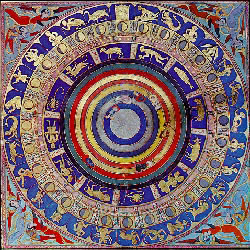 Celestial map, signs of the Zodiac and lunar mansions.
Celestial map, signs of the Zodiac and lunar mansions.
The art of Ottoman Turkish miniature painting reached its peak in the sixteenth century, especially during the reigns of Suleyman the Magnificent and Murad III, who were both great patrons of art responsible for the uninterrupted output of the imperial ateliers during this period. Most of the miniatures executed in the sixteenth century took their subjects from Ottoman history illustrating major political and social events of the time. Less attention was given to producing literary manuscripts. Illustrated religious texts which increased in number later in the century very often remained in a historical framework. That is, in some of the major books on world history, Ottoman sultans were linked genealogically with Koranic and Biblical prophets. The Zubdat-al Tawarikh is a book of that nature where the text is a summary of Biblical and political world history covering the creation of the world, stories of the prophets and prominent historical figures of the past, and largely Turkish history to the time of the reigning sultan Murad III, also including genealogical accounts of the first twelve Ottoman sultans. The author was Seyyid Loqman Ashuri, the prolific historiographer of the Ottoman court during the period of Murad III, who in his introduction explains how he compiled this world history from different sources.
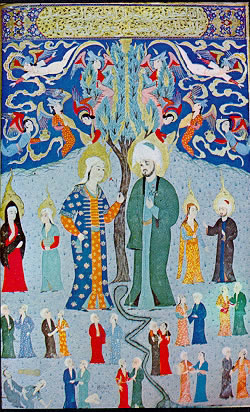 Adam and Eve with their twin children.
Adam and Eve with their twin children.
In addition to the Zubdat al-Tawarikh in the Museum of Turkish and Islamic Works, two other copies of Lokman's work exist in Topkap² Saray museum Library H. 1321, dated 1586, and Dublin, Chester Beatty Librar, no.414, dated 1573.
The manuscript is rather large in size (64,7x41,3 cm.) with ninety-one folios and forty miniatures, twenty-three of which illustrate the stories of the prophets, five are portraits of the caliphs and the founders of the Islamic rites and the last twelve are portraits of the first twelve Ottoman sultans.
The manuscript's miniatures are of great significance iconographical and stylistically leading to a deeper insight to Turkish religious art and portraiture. The large number of miniatures allotted to the stories of the prophets from the earliest Noah's ark and the deluge examples of Ottoman religious painting. Some of the images follow the traditional iconographical schemes of the earlier fourteenth and fifteenth century Islamic miniatures but most of them are new interpretations reflecting the Ottoman approach to religious subject matter. The directness and clarity with which the ottoman artist narrates his historical subjects seem to be repeated in these 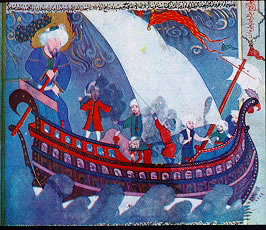 illustrations where the story of each prophet is summarised and represented in a convincingly realistic way marked by an accuracy of detail. The prophets are depicted generally in attire similar to the figures found in the historical miniatures of the period, namely a belted dress and a caftan with embroideries on the collar and the sleeves, and it is only their halos that mark their holy character. The prophets are shown sitting crossed legged or in a kneeling position. If the prophet is praying, his hands are raised in a gesture of prayer, if he is in the act of giving advice, his left hand is slightly raised. The Biblical kings wear similar garments but are crowned Non-muslims or infidels wear a plain garment and a simple cap.
illustrations where the story of each prophet is summarised and represented in a convincingly realistic way marked by an accuracy of detail. The prophets are depicted generally in attire similar to the figures found in the historical miniatures of the period, namely a belted dress and a caftan with embroideries on the collar and the sleeves, and it is only their halos that mark their holy character. The prophets are shown sitting crossed legged or in a kneeling position. If the prophet is praying, his hands are raised in a gesture of prayer, if he is in the act of giving advice, his left hand is slightly raised. The Biblical kings wear similar garments but are crowned Non-muslims or infidels wear a plain garment and a simple cap.
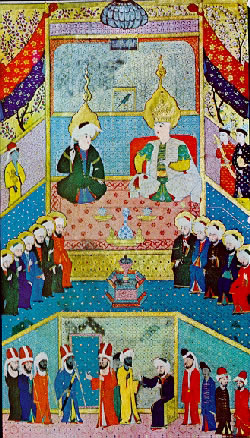 Joseph with his father Jacob and brothers in Egypt
Joseph with his father Jacob and brothers in Egypt
The first miniature in the Zubdat-al Tawarikh is a celestial map with the earth surrounded by seven heavens, signs of the Zodiac and the lunar mansions, symbolising the macrocosm. (fig I)
The stories of the prophets start with Adam and Eve. An interesting interpretation of this story is found in a miniature where Adam and Eve are shown with their thirteen twin children. (fig 2). As the text indicates, all of Adam's children were twins and each son had to marry the twin sister of a brother. Abel was asked by his father to wed Cane's twin sister, but Cane, whose twin happened to be the most beautiful wanted to keep her. This is how the dispute started between the two brothers. To end the dispute Adam asked both sons to make an offering to God and Abel's was accepted. This interesting version of the story is depicted in the lower left hand corner, where Cane is shown pulling the arm of his twin sister. The bushes, the symbol of Cane's offering, rest above the figures of Cane and his sister. Earlier Islamic artists, when illustrating the story of Adam and Eve, usually showed the couple in paradise but never placed them with their children, nor represented this version of the dispute between Cane and Abel. The Ottoman artist's narrative intent comes in here when he describes the story in the minutest detail and dresses his figures in sixteenth century Ottoman garments as if the theme was a local event.
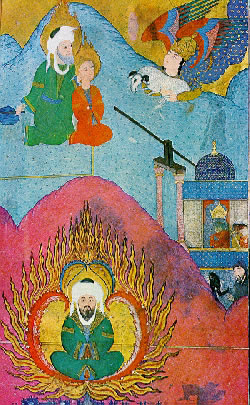 Abraham sacrificicing his son, Ishmael Abraham cast into fire by Nimrod
Abraham sacrificicing his son, Ishmael Abraham cast into fire by Nimrod
A story often illustrated in Islamic manuscripts as well as in the Western world is that of Noah's ark and the deluge. In its representation in the Zubdat-al Tawarikh, Noah's ark is caught in the thunderstorm and the heavy rain that will flood the earth (fig 3). One of the masts in the ship is bent from the strong wind and Noah's sons are shown moving to and fro with anxiety trying to control the sails. Noah has calmly grabbed the rudder. The ark is represented as a sixteenth century Ottoman ship very similar to images found in illustrations of the Ottoman fleet in historical miniatures of the time. On the other hand in accordance with its Biblical description, it has two stories, through the windows of which pairs of animals can be observed. The text of the Zubdat-al Tawarikh states that the number of Noah's sons varies in source. The artist here has chosen to represent the prophet with seven sons and to interpret the story of the deluge as the common adventure of any ship caught in a storm.
Stories of Prophet Joseph are widely illustrated in the Islamic world. The prophet's adventures with his brothers and especially with Zoeyha have been a source of inspiration for many Islamic poets and artists. In a miniature in the Zubdat-al Tawarikh Joseph is shown enthroned with his father Jacob and his brothers, after he succeeded to settle in Egypt in spite of all his adventures with his brothers (fig. 4) The story tells how upon Joseph's wish his brothers brought their father to Egypt and how his brothers had to ask him for food after the occurrence of the well known famine. Nevertheless, in the lower section of the miniature, several people, differently dressed, are shown waiting to get their share of the grain. The representation of this episode in Joseph's life has no counterpart in Islamic miniature painting. The Ottoman painter must have chosen this theme of the reunion of Joseph's family, because it was the most suitable for a courtly representation and therefore more appropriate for the pictorial taste of the period. Courtly representations and enthronement scenes were very common in sixteenth century Ottoman historical miniatures, and the artist applied the same composition scheme to his religious subject matter.
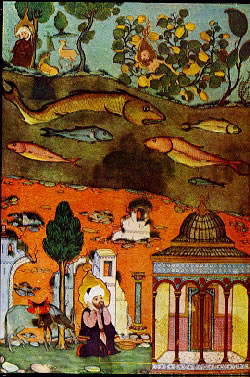 Jonah and the fish Jeremiah in wilderness Uzeyr awakened after the destruction of Jerusalem
Jonah and the fish Jeremiah in wilderness Uzeyr awakened after the destruction of Jerusalem
Perhaps even a more popular Biblical and Koranic prophet is Abraham, whose life is extensively narrated in the Koran. His being cast into fire by King Nimrod or the sacrifice of his son, who according to Islamic sources was Ishmael not Isaac, are often represented in miniatures. In the Zubdat-al Tawarikh, both stories are depicted on the same page (fig. 5). Above, Abraham is shown sharpening his knife and when he is about to sacrifice his son, an angel suddenly comes, into the scene holding the sacrificial ram. Ishmael, his eyes closed, is waiting calmly. Below, the prophet has been cast into fire by Nimrod as a punishment for destroying his father's idols, but he is seated in the midst of flames, miraculously unharmed. Nimrod, the devil, and the magician are watching the incident with great astonishment.
The next miniature in the manuscript shows the destruction of Sodom (fig. 6). The doomed city is overthrown by heavenly fire and stones, and the sinful inhabitants of Sodom are drowned in the flood. Some of the people are in the waters struggling to survive with arms stretched ut crying for help. The angel on the left has fulfilled his mission, while Prophet Lot on the left, dressed in a blue caftan, is praying to God in deep grief.
The story depicted in the section below the image of Lot, is about Safwan, mentioned in Islamic sources as the prophet who saved his people by destroying the giant bird Anka to whom a youth was sacrificed each day.
One of the recurring themes in Islamic religious painting is the well-known miracle of Moses and Aaron, who produced a serpent dragon from a rod before the Pharoah.
The story is illustrated in one of the miniatures in the Zubdat-al Tawarikh, where the Pharoah is shown sitting in a loggia astonished at the miracle just performed, while magicians and courtiers are watching from the windows (fig. 7). The miracle of the rod has obviously taken place in the palace gardens where the loggia forms a bridge over the brook flowing in a curveà Carefully drawn settings with a wealth of architectural elements are characteristic features of the Ottoman painting style of the second half of the sixteenth century.
Interiors are also drawn with great care as in the image showing Prophet Elijah and his successors (fig. 8). The prophet's followers are in the process of changing their caps, symbolising their conversion. This type of headdress was used by Ottoman artists to point out the non-muslims in historical miniatures of the time. Below on the same image, is found the story of Prophet Ezekiel. The text states that Prophet Ezekiel, seeing the children of Israel killed by the plague, prayed to God for their resurrection. The mission was granted to him. The prophet is shown here standing among the tombs with one hand raised in gesture of resurrecting the dead, some of which have already emerged from their coffins while others are still a pile of skeletal bones scattered all over the field.
Still another miniature depicts the stories of three different prophets (fig. 9). In the upper section is found the story of Jonah and the fish. Jonah, the text tells tried to avoid his mission by sailing away but was caught by a violent storm. He was then swallowed by a fish and after three days left on shore. In the miniature Prophet Jonah is shown trying to hide nis nakedness in the midst of bushes. Below him is a brook full of brightly colored fish. On the upper left hand corner, another prophet is represented. Sitting among trees and animals according, to the text, Prophet Jeremiah, grieving over the destruction of Jerusalem by Babylonians, hid in a wild forest. A similar story is narrated in the text for Prophet Uzeyr, depicted in the lower section of the miniatures, who also grieved over the destruction of the Holy City but his grief was so deep that God took his soul and gave him life, years after Jerusalem was reconstructed. The building on the lower right hand corner undoubtedly symbolises the rebuilt city of Jerusalem, yet it is the accurate rendering of a typical sixteenth century Ottoman building with a dome and an arched portico. The ruins of the once destroyed city, on the other hand, are indicated by broken arches and columns on the left.
Another miniature depicting more than one story shows Prophets Jircis and Samson (fig. 10). According to the story in the text, Jircis was tortured by the Malik of Mosul as a punishment for his holy mission. His body was burnt and cut up into pieces but each time God restored him to life. In the end, he was cut in half by a sword and died, upon which incident the people of Mosul were destroyed by heavenly fires. The prophet Jircis, on the other hand, was buried by angels. This episode is depicted in the section above where the prophet is ready to be buried in a tomb dug by angels. Below on the same miniature, is the well known story of Samson. Samson, who owed his strength to his vow to God that the would never cut his hair, was betrayed to his enemies by Delilah, and his revenge came when he pulled down the Philistine temple. Samson is shown here pulling one of the columns is the temple to tear down the whole building.
One of the recurring themes of the Christian and Islamic worlds is the Seven Sleepers (fig II). The text of the Zubdat-Al-Tawarikh states that seven young men in search of God ran away from the ruthless king Doxianus and hid in a cave with their dog. God put them to sleep there for three hundred years. In the miniature, the seven sleepers, each dressed in a differently colored Ottoman caftan, are seen sleeping in their cave. The image is a perfect example of the colour scheme with bright tones characteristic of the painting style of the period.
A miniature of iconographical interest is a representation of the ascension of Christ (fig. 12). The text states that Feltianus, who was chosen by the Jews to execute Jesus, was suddenly given by God the appearance of Christ and therefore he himself was executed instead. Christ, on the other hand, was ascended to heaven by angels. This is shown in the section above where he is lifted by two angels. Below on the right, the figure identical in appearance to Jesus is Feltiyanus, caught by the Jews. Others are astonished at the miraculous ascension of Christ to heaven. This is iconographical a unique verion of the story in Islamic painting.
Equally interesting is the miniature showing Miraj, the ascension of Prophet Mohammed to seven heavens (fig. 13). The Prophet is shown sitting in a mosque with Ali, Hasan, Huseyin and friends. A flaming halo crowns him and extends into the sky above. The descending angels and Gabriel have come to take the Prophet on his nocturnal journey. Miraj is not described extensively in the text, but the scene obviously takes place in a mosque, possibly the Dome of the Rock in Jerusalem. Islamic sources in general agree on the Prophet's ascension to heaven from Jerusalem. The ottoman artist undoubtedly intended to represent a holy building in Jerusalem and was possibly influenced by descriptions of buildings in that city. In Islamic miniatures Miraj is a recurring theme but in almost all the representations the Prophet is seen mounted on Buraq, the human headed beast, riding among clouds accompanied by angels. The Ottoman artist on the other hand has chosen to represent this very important episode from the Prophet's life in an everyday environment, emphasising the stage before his entry into the celestial world, which is represented above as a separate section.
The last part of the Zubdat-al Tawarikh contains portraits of the first twelve Ottoman Sultans-Several albums were prepared during the period of Murad III with portraits of the Ottoman sultans and it was through these albums that a model was set our for each sultan and followed for centuries. The portraits in the Zubdat-al Tawarikh are therefore as significant a source as these albums. The miniature showing Murad III should be noted as the portrait of the reigning sultan drawn from life. (fig. 14) The miniatures of the Zubdat-al Tawarikh are unsigned like many of the Ottoman miniatures but a stylistic analysis reveals at least four to five different hands and the assistance of apprentices is some of the miniatures. Nevertheless, a document; a salary register, recently found in the State Archives gives a list of painters, illuminators, book-binders who worked on the manuscript and shows that a large groups of artist, the most prominent of the time, contributed to this royal commission. Thirteen painters and illuminators, among which were well known artists such as Osman, Ali Lutfu, Mehmed, Molla Kasim and Huseyin, were responsible for the illustrations in the manus cript. A group of exceptionally skilful painters collaborated on such a manuscript that required great care as it dealt with the genealogical background of Murad III to whom it was dedicated. At the same time, the miniatures in such a manuscript required new insight to religious iconography. The Zubdat-al Tawarikh is a rare Ottoman religious manuscript in which the stories of the prophets are represented so extensively. Therefore; the work must have required a group of artists qualified for the execution of these miniatures, iconographical rather different for the painters of Ottoman historiographical subjects. Thus, the miniatures of the Zubdat-al Tawarikh in the Museum of Turkish and Islamic Arts are significant examples of Ottoman religious painting and portraiture during a period whose major concern was illustration of current history.
Source: Turkish Treasures Culture/ Art/ Tourism Magazine 1978/1
By: Assoc. Prof. Dr. Günsel Renda, Hacettepe University, ANKARA








